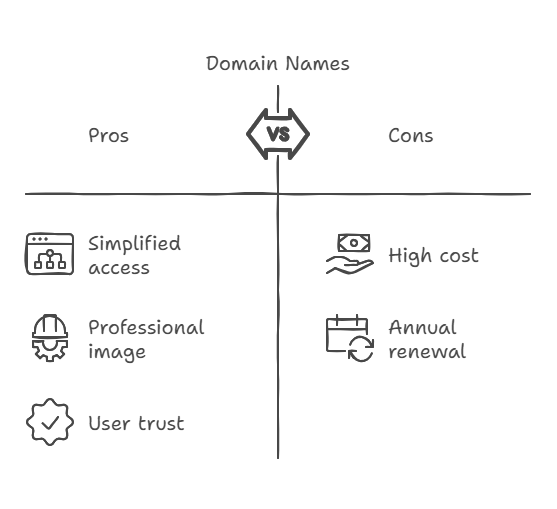What Is The Difference Between Domain Name And Url? The difference between a domain name and a URL is often misunderstood. These terms are used frequently but serve very different purposes.
Understanding the distinction can help you navigate the internet more effectively and manage your online presence efficiently.
This review covers what domain names and URLs are, their features, pros, cons, and frequently asked questions.
Domain Names and Their Significance
What Is a Domain Name?
The domain name serves as a virtual address for a website, allowing users to access it by typing it into their browser instead of entering a numerical IP address.
You input “google.com” as a shortcut for typing out the IP address “172.217.11.174.” Domain names simplify web navigation for users.
They are essential for branding and are widely recognized as the online address of a business or individual.

Key Components of a Domain Name
- Top-Level Domain (TLD): This is the extension, such as .com, .org, or .edu.
- Second-Level Domain (SLD): “The primary component of the title, such as ‘google’ in google.com.”
- Subdomains: Optional prefixes like “www” or “blog” that indicate specific sections.
How Domain Names Work
When you type a domain name into your browser, it triggers a process called DNS (Domain Name System) resolution.
The DNS translates the domain name into an IP address, enabling the browser to connect to the correct server.
Features of Domain Names
- Memorability: Domain names are easy to remember.
- Customization: You can choose a name aligned with your brand.
- Consistency: Domains work the same way across the internet.
Advantages of Domain Names
- Simplify website access.
- Create a professional image for businesses.
- Build trust among users.
Drawbacks of Domain Names
- Premium domains can be costly.
- Domain registration needs annual renewal.
Examples of Domain Names
- Commercial Sites: amazon.com
- Educational Institutions: mit.edu
- Nonprofits: unicef.org
URLs and Their Role
What Is a URL?
The term URL refers to a complete web address, or Uniform Resource Locator. It specifies how to access a resource on the internet.
The URL contains more information than just the domain name. For example:
https://www.example.com/contact-us

- Protocol: HTTPS indicates secure communication.
- Domain Name: example.com is the central identifier.
- Path: /contact-us points to a specific page.
Key Components of a URL
- Protocol: HTTP or HTTPS defines the communication method.
- Domain Name: The core identifier of the website.
- Path: Indicates the specific file or resource location.
- Parameters: Provide extra information, such as search terms or user preferences.
How URLs Work
The server receives a request from the browser when you enter a URL. The server handles this request and sends the correct webpage.
Features of URLs
- Precision: URLs guide users to exact locations.
- Flexibility: Work with dynamic pages and queries.
- Comprehensiveness: Include all necessary details for resource retrieval.
Advantages of URLs
- Provide detailed information about resource locations.
- Support dynamic website structures.
- Enhance user experience with keyword-rich paths.
Drawbacks of URLs
- Typing or sharing long URLs can pose a challenge.
- Require consistent management to prevent broken links.
Examples of URLs
- Homepage: https://www.example.com
- Specific Page: https://www.example.com/about-us
- Search Query: https://www.example.com/search?q=example
Comparison of Domain Names and URLs
| Aspect | Domain Name | URL |
| Purpose | Identifies a website. | Points to specific resources. |
| Complexity | Simple and easy to remember. | Can be long and detailed. |
| Components | SLD, TLD, optional subdomain. | Includes protocol, domain, and path. |
| User Interaction | Entered to access a site. | Entered for specific resources. |
FAQs About What Is The Difference Between Domain Name And Url
Q1# What happens if my domain name is unavailable?
You can try a variation or choose a different TLD.
Q2# Is HTTPS important for my URL?
Yes, HTTPS improves security and boosts trust among users.
Q3# Can I use a domain name without a URL?
No, URLs rely on domain names to function.
Q4# Why are URLs so long sometimes?
They include detailed paths and parameters for resource identification.
Q5# Can I shorten my URL for sharing?
Yes, tools like Bitly or TinyURL can help.
Q6# What if my URL stops working?
Check for broken links or server issues to restore functionality.
Conclusion
Domain names and URLs play distinct but complementary roles online.
A domain name serves as the website’s main identifier, while a URL directs users to specific resources.
Together, they confirm smooth navigation and enhance user experience.
Understanding these concepts allows better decisions about branding, website design, and online interactions.
By using both effectively, you can create a seamless web presence.


